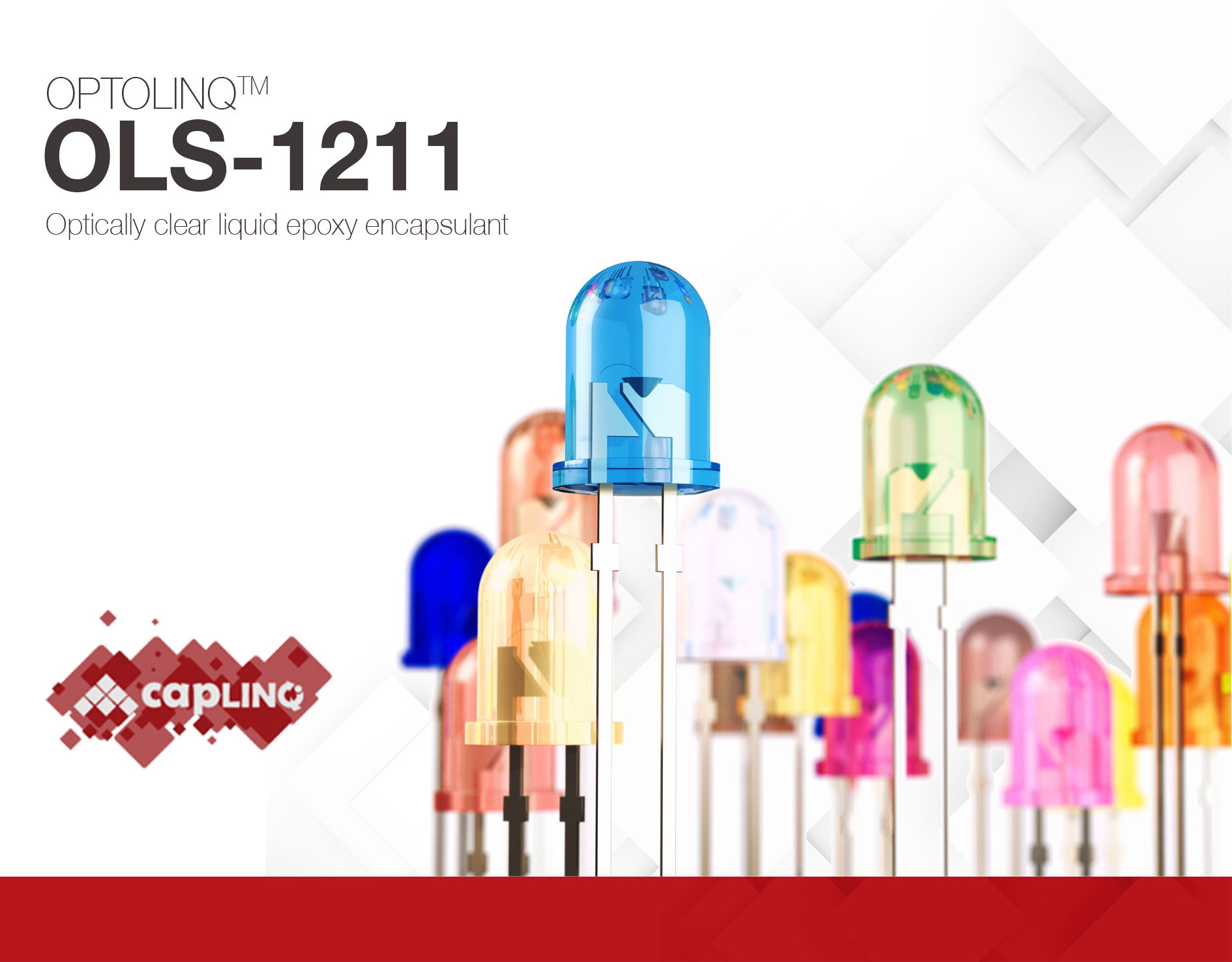OLS-1211 | Liquid Encapsulant - Two part Epoxy
- Epoxy potting compound
- Better anti blue and UV resistance
- Encapsulation of LED lamps and displays
Product Description
OPTOLINQ OLS-1211 is a two-component (Part A & Part B), low halogen, optically clear epoxy casting compound designed for the encapsulation of LED lamps and displays. Part A is an epoxy resin while part B is primarily a modified curing agent.
OPTOLINQ OLS-1211 offers excellent bonding properties to a wide range of substrates and good resistance against heat aging, cold and thermal shock. Additionally, this epoxy encapsulant features over then 99% visible light transmittance and low light decay. It has much better UV resistance and antiblue properties than OLS1000.
OPTOLINQ OLS-1211 has been developed for applications that will not be exposed to temperatures above 125°C but it can pass the SMD reflow process at 260 °C. It has been used extensively for low-power LED encapsulation, automatic LED casting, and potting of large optoelectronic modules. It can be colored and diffused by the addition of specific dye and diffusing concentrates.
Technical Specifications
| General Properties | |||||||
| Refractive index Refractive index The refractive index determines how much the path of light is bent, or refracted, when entering a material. It is calculated by taking into account the velocity of light in vacuum compared to the velocity of light in the material. The refractive index calculation can be affected by the wavelength of light and the temperature of the material. Even though it is usually reported on standard wavelengths it is advised to check the TDS for the precise test parameters. | 1.52 | ||||||
| Work life @25°C Work life @25°C Work life is the amount of time we have to work with a material until it is no longer able to be easily worked and applied on a substrate. It is based on the change in viscosity and it can rely on the application requirements. | 4 hours | ||||||
| Physical Properties | |||||||
| Viscosity Viscosity Viscosity is a measurement of a fluid’s resistance to flow. Viscosity is commonly measured in centiPoise (cP). One cP is defined as the viscosity of water and all other viscosities are derived from this base. MPa is another common unit with a 1:1 conversion to cP. A product like honey would have a much higher viscosity -around 10,000 cPs- compared to water. As a result, honey would flow much slower out of a tipped glass than water would. The viscosity of a material can be decreased with an increase in temperature in order to better suit an application | 1,100 mPa.s | ||||||
| Chemical Properties | |||||||
| Water Absorption | 0.3 % | ||||||
| Mechanical Properties | |||||||
| |||||||
| Thermal Properties | |||||||
| |||||||
| |||||||
| Glass Transition Temperature (Tg) Glass Transition Temperature (Tg) The glass transition temperature for organic adhesives is a temperature region where the polymers change from glassy and brittle to soft and rubbery. Increasing the temperature further continues the softening process as the viscosity drops too. Temperatures between the glass transition temperature and below the decomposition point of the adhesive are the best region for bonding. The glass-transition temperature Tg of a material characterizes the range of temperatures over which this glass transition occurs. | 127 °C | ||||||
Additional Information
Operating instructions
We recommend to process the product in a clean room at room temperature with a relative humidity lower than 35%.
- Preheat Part A to 50-55°C for 2 hours, making sure that you adjust this to the external temperature. Do not preheat for more that 24 hours.
- Mix part A with the diffusion agent and the pigment and stir well. Afterwards add Part B in a 100:100 ratio.
- To ensure that all the entrapped air bubbles are removed after mixing, the mixture of Part A and B should be done in a vacuum and degassed at 0.1MPa for 10-15 minutes.
- Clean and dry the glue injection tool. Use it within 90minutes in room temperature and under tightly sealed conditions, ideally in a vacuum.
Curing
It is advised to cure in two stages to reduce thermal stress.
- The mixture should be cured in the over within 30 minutes after dispensing.
- The over should be already preheated to the curing temperature.
- After the initial cure is finished the post curing should be carried out within 2 hours, ideally in the same oven.
Cure Schedule
- 1hour @ 130-135°C + 6-8hours @ 130-135°C
- 1hour @ 125-130°C + 6-8hours @ 130-135°C
- 1hour @ 105-120°C + 6-8hours @ 130-135°C
Using Additives
Optolinq OLS-1211 can be mixed with diffusing agents or color pastes to achieve customer-specific purposes.
Recommended quantity of various diffusing agents and color pastes:
- OPC-R Red Color Paste: 0.1-0.5% by epoxy weight
- OPC-B Blue Color Paste: 0.1-0.5% by epoxy weight
- OPC-G Green Color Paste: 0.1-0.5% by epoxy weight
- ODF-090 Diffusing Agent: 3-5% by weight (LED lamps), 4-8% (LED displays)
For example, ODF would be 100 : 100 : 3~5 for LED lamps
Storage and Handling
OPTOLINQ OLS-1211 is supplied in 5Kg cans and should be kept in a cool and dry place (40% – 75% humidity) away from direct sunlight or temperature extremes. It should not contact any acid and alkali substances. Consult the Safety data sheet for the handling of this product
The product comes in fluorinated drums. Please keep it at 0-30° and use it within the shelf life .After the Can is opened, the unused product should avoid prolonged contact with air. Try to tightly seal the package to ensure its stable performance.
Shelf life at 0-30°C:
Part A: 6 months
Part B: 3 months
Data Ranges
The data contained herein are reported as typical values and/or range values based on actual test data and are verified on a periodic basis. They are reference values and not guaranteed specifications.



